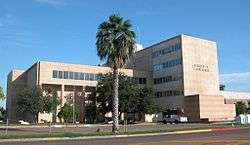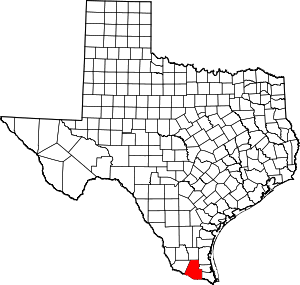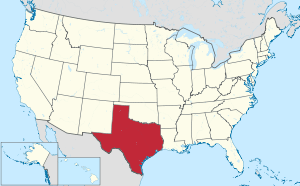Hidalgo County, Texas
Hidalgo County (/hɪˈdælɡoʊ/; Spanish pronunciation: [iˈðalɣo]) is a county in the U.S. state of Texas. The county seat is Edinburg[1] and the largest city is McAllen. The county is named for Miguel Hidalgo y Costilla, the priest who raised the call for Mexico's independence from Spain.[2] It is located in the Rio Grande Valley of South Texas and is one of the fastest-growing counties in the United States. As of the 2010 census, the population of Hidalgo County was 774,769,[3] making it the eighth-most populous county in Texas. Hidalgo County is designated by the U.S. Census Bureau as the McAllen-Edinburg-Mission Metropolitan Statistical Area, which itself is part of the McAllen-Edinburg-Mission-Rio Grande City Combined Statistical Area with neighboring Starr County.
Hidalgo County | |
|---|---|
| County of Hidalgo | |
 The Hidalgo County Courthouse at Edinburg in 2002 | |
 Flag  Seal | |
 Location within the U.S. state of Texas | |
 Texas's location within the U.S. | |
| Coordinates: 26°24′N 98°11′W | |
| Country | |
| State | |
| Founded | 1852 |
| Named for | Miguel Hidalgo y Costilla |
| Seat | Edinburg |
| Largest city | McAllen |
| Area | |
| • Total | 1,583 sq mi (4,100 km2) |
| • Land | 1,571 sq mi (4,070 km2) |
| • Water | 12 sq mi (30 km2) 0.81%% |
| Population (2010) | |
| • Total | 774,769 |
| • Density | 493/sq mi (190/km2) |
| Time zone | UTC−6 (Central) |
| • Summer (DST) | UTC−5 (CDT) |
| Congressional districts | 15th, 28th, 34th |
| Website | www |
Geography
According to the U.S. Census Bureau, the county has a total area of 1,583 square miles (4,100 km2), of which 1,571 square miles (4,070 km2) are land and 12 square miles (31 km2) (0.8%) are covered by water.[4] The northern part of the county has sandy and light loamy soils over deep reddish or mottled, clayey subsoils. In some areas, limestone lies within 40 in (1 m) of the surface. The southern part of the county has moderately deep to deep loamy surfaces over clayey subsoils. Along the Rio Grande, brown to red clays occur. Hidalgo County is in the South Texas Plains vegetation area, which features grasses, mesquite, live oaks, and chaparral. Native plants, reduced in recent years by extensive farming, include chapote, guayacan, ebony, huisache, brasil, and yucca.
In 1982, 91% of the land was in farms and ranches, with 52% of the farmland under cultivation and 85% irrigated; 51 to 60% of the county was considered prime farmland. The primary crops were sorghum, cotton, corn, and vegetables; Hidalgo County led Texas counties in the production of cabbage, onions, cantaloupes, carrots, and watermelons. The primary fruits and nuts grown in the county were grapefruit, oranges, and pecans. Cattle, milk cows, and hogs were the primary livestock products. Natural resources included caliche, sand, gravel, oil, and gas. Oil and gas production in 1982 totaled 98,487,211,000 cubic feet (2.7888472×109 m3) of gas-well gas, 139,995 barrels of crude oil, 1,101,666 barrels of condensate, and 15,784,000 cubic feet (447,000 m3) of casinghead gas. The climate is subtropical and subhumid. Temperatures range from an average low of 47 °F (8 °C) in January to an average high to 96 °F (36 °C) in July; the average annual temperature is 73 °F (23 °C). Rainfall averages 23 inches (580 mm) a year, and the growing season lasts for 320 days of the year.[5]
Major highways
.svg.png)
.svg.png)























Adjacent counties and municipalities
- Brooks County (north)
- Kenedy County (northeast)
- Willacy County (east)
- Cameron County (east)
- Starr County (west)
- Gustavo Díaz Ordaz Municipality, Tamaulipas, Mexico (south)
- Reynosa Municipality, Tamaulipas, Mexico (south)
- Río Bravo Municipality, Tamaulipas, Mexico (south)
- Matamoros Municipality, Tamaulipas, Mexico (southeast)
National protected areas
Demographics
| Historical population | |||
|---|---|---|---|
| Census | Pop. | %± | |
| 1860 | 1,182 | — | |
| 1870 | 2,387 | 101.9% | |
| 1880 | 4,347 | 82.1% | |
| 1890 | 6,534 | 50.3% | |
| 1900 | 6,837 | 4.6% | |
| 1910 | 13,728 | 100.8% | |
| 1920 | 38,110 | 177.6% | |
| 1930 | 77,004 | 102.1% | |
| 1940 | 106,059 | 37.7% | |
| 1950 | 160,446 | 51.3% | |
| 1960 | 180,904 | 12.8% | |
| 1970 | 181,535 | 0.3% | |
| 1980 | 283,229 | 56.0% | |
| 1990 | 383,545 | 35.4% | |
| 2000 | 569,463 | 48.5% | |
| 2010 | 774,769 | 36.1% | |
| Est. 2019 | 868,707 | [6] | 12.1% |
| U.S. Decennial Census[7] 1850–2010[8] 2010–2019[3] | |||
2015 Texas Population Estimate Program
As of the 2015 Texas Population Estimate Program, the population of the county was 841,667, non-Hispanic whites 62,232 (7.4%). Black Americans 2,973 (0.3%). Other non-Hispanic 11,106 (1.3%). Hispanics and Latinos (of any race) 765,356 (90.9%).[9]
2010 Census
As of the 2010 United States Census, there were 774,769 people living in the county. 88.0% were White, 1.0% Asian, 0.6% Black or African American, 0.3% Native American, 8.8% of some other race and 1.3% of two or more races. 90.6% were Hispanic or Latino (of any race).
There were 216,471 households, and 179,668 families living in the county. The population density was 363 people per square mile (140/km2). There were 248,287 housing units at an average density of 123 per square mile (47/km2). There were 216,471 households, out of which 54.2% had children under the age of 18 living with them, 65.00% were married couples living together, 18.8% had a female householder with no husband present, and 17.0% were non-families. 14.0% of all households were made up of individuals, and 5.6% had someone living alone who was 65 years of age or older. The average household size was 3.55 and the average family size was 3.94.
In the county, the population was spread out, with 34.7% under the age of 18, 10.7% from 18 to 24, 27.1% from 25 to 44, 18.2% from 45 to 64, and 9.3% who were 65 years of age or older. The median age was 28.3 years. For every 100 females there were 94.40 males. For every 100 females age 18 and over, there were 89.90 males.
The median income for a household in the county was $30,134, and the median income for a family was $31,760. Males had a median income of $22,635 versus $17,526 for females. The per capita income for the county was $12,130. About 32.60% of families and 35.80% of the population were below the poverty line, including 47.4% of those under age 18 and 29.8% of those age 65 or over. The county's per-capita income makes it one of the poorest counties in the United States. In 2009, it was tied with Bronx County, New York for "the greatest share of people receiving food stamps: 29 percent."[10]
Las Milpas, previously unincorporated, was annexed by Pharr in 1987.[11]
Metropolitan Statistical Area
The United States Office of Management and Budget has designated Hidalgo County as the McAllen-Edinburg-Mission, TX Metropolitan Statistical Area.[12] The United States Census Bureau ranked the McAllen-Edinburg-Mission, TX Metropolitan Statistical Area as the 70th most populous metropolitan statistical area of the United States as of July 1, 2012.[13]
The Office of Management and Budget has further designated the McAllen-Edinburg-Mission, TX Metropolitan Statistical Area as a component of the more extensive McAllen-Edinburg, TX Combined Statistical Area,[12] the 60th most populous combined statistical area and the 67th most populous primary statistical area of the United States as of July 1, 2012.[13][14]
Government and politics
Hidalgo County tends to vote for the Democratic Party, although there is representation of the Republican Party in some of the offices that affect the county. Hidalgo County is represented by Vicente González of Texas's 15th congressional district, Henry Cuellar of Texas's 28th congressional district and Filemon Vela Jr. of Texas's 34th congressional district. In the 2012 presidential election, 70.4% of the voters voted for Barack Obama while 28.6% voted for Mitt Romney. The last time Hidalgo County voted Republican was in the 1972 presidential election when Richard Nixon won over 55% of the votes.
| Year | Republican | Democratic | Third parties |
|---|---|---|---|
| 2016 | 27.9% 48,642 | 68.1% 118,809 | 4.0% 6,957 |
| 2012 | 28.6% 39,865 | 70.3% 97,969 | 1.1% 1,488 |
| 2008 | 30.3% 39,668 | 68.9% 90,261 | 0.8% 1,043 |
| 2004 | 44.8% 50,931 | 54.9% 62,369 | 0.3% 383 |
| 2000 | 37.9% 38,301 | 60.8% 61,390 | 1.4% 1,359 |
| 1996 | 28.8% 24,437 | 66.5% 56,335 | 4.7% 3,955 |
| 1992 | 30.6% 26,976 | 58.1% 51,205 | 11.3% 9,979 |
| 1988 | 34.9% 29,246 | 64.8% 54,330 | 0.4% 294 |
| 1984 | 44.1% 35,059 | 55.6% 44,147 | 0.3% 226 |
| 1980 | 41.8% 25,808 | 56.0% 34,542 | 2.2% 1,367 |
| 1976 | 35.2% 19,199 | 64.2% 35,021 | 0.7% 373 |
| 1972 | 55.2% 22,920 | 44.3% 18,366 | 0.5% 213 |
| 1968 | 39.0% 14,455 | 54.1% 20,087 | 6.9% 2,569 |
| 1964 | 34.3% 11,563 | 65.5% 22,110 | 0.3% 83 |
| 1960 | 42.1% 13,628 | 57.6% 18,663 | 0.4% 115 |
| 1956 | 56.9% 13,270 | 42.0% 9,804 | 1.1% 253 |
| 1952 | 62.2% 15,303 | 37.6% 9,251 | 0.2% 48 |
| 1948 | 38.8% 6,220 | 59.5% 9,526 | 1.7% 272 |
| 1944 | 33.4% 4,080 | 59.3% 7,250 | 7.4% 904 |
| 1940 | 39.0% 4,787 | 60.8% 7,471 | 0.2% 27 |
| 1936 | 29.5% 2,962 | 67.5% 6,782 | 3.1% 309 |
| 1932 | 23.2% 2,969 | 75.8% 9,695 | 0.9% 120 |
| 1928 | 51.4% 4,285 | 48.4% 4,034 | 0.2% 16 |
| 1924 | 20.4% 996 | 75.2% 3,662 | 4.4% 214 |
| 1920 | 31.1% 1,108 | 67.7% 2,409 | 1.2% 42 |
| 1916 | 15.7% 260 | 82.3% 1,364 | 2.0% 33 |
| 1912 | 2.8% 39 | 86.6% 1,203 | 10.6% 147 |
County services
The Hidalgo County Sheriff's Office operates jail facilities and is the primary provider of law enforcement services to the unincorporated areas of the county.
County government
| Position | Name | Party | |
|---|---|---|---|
| County Judge | Richard Cortez | Democratic | |
| Commissioner, Precinct 1 | David Fuentes | Democratic | |
| Commissioner, Precinct 2 | Eduardo "Eddie" Cantu | Democratic | |
| Commissioner, Precinct 3 | Joe M. Flores | Democratic | |
| Commissioner, Precinct 4 | Ellie Torres | Democratic | |
| Criminal District Attorney | Ricardo Rodriguez | Democratic | |
| District Clerk | Laura Hinojosa | Democratic | |
| County Clerk | Arturo Guajardo, Jr. | Democratic | |
| Sheriff | J.E. "Eddie" Guerra | Democratic | |
| Tax Assessor-Collector | Pablo "Paul" Villarreal | Democratic | |
| Treasurer | Lita Leo | Democratic | |
| Constable, Precinct 1 | Celestino Avila, Jr. | Democratic | |
| Constable, Precinct 2 | Martin Cantu | Democratic | |
| Constable, Precinct 3 | Lazaro Gallardo, Jr. | Democratic | |
| Constable, Precinct 4 | Atanacio "J.R." Gaitan | Democratic | |
| Constable, Precinct 5 | Danny Marichalar | Democratic | |
Education
The following school districts serve Hidalgo County:
- Donna Independent School District
- Edcouch-Elsa Independent School District
- Edinburg Consolidated Independent School District
- Hidalgo Independent School District
- La Joya Independent School District
- La Villa Independent School District
- Lyford Consolidated Independent School District (partial)
- McAllen Independent School District
- Mercedes Independent School District
- Mission Consolidated Independent School District
- Monte Alto Independent School District
- Progreso Independent School District
- Pharr-San Juan-Alamo Independent School District
- Sharyland Independent School District
- Valley View Independent School District
- Weslaco Independent School District
In addition, the county is served by the multi-county South Texas Independent School District. The Catholic Diocese of Brownsville operates three PK-8th Grade schools, two lower-level elementary schools and two high schools.
The Edinburg campus of the University of Texas Rio Grande Valley (formerly University of Texas-Pan American) is located in Hidalgo County. The Pecan, Mid-Valley, Technology, and Nursing & Allied Health campuses of South Texas College are also located in Hidalgo County.[16]
Media
Newspapers
- The Valley Town Crier
- The Edinburg Review
- The Monitor
- The Mid Valley Town Crier
- RGV Business Journal
- The Progress Times
- Texas Border Business
- Mega Doctor News
Radio stations
Magazine
Communities
Cities
Census-designated places
- Abram
- Alton North (former)
- Cesar Chavez
- Citrus City
- Cuevitas
- Doffing
- Doolittle
- Faysville
- Hargill
- Havana
- Heidelberg
- Indian Hills
- La Blanca
- La Homa
- Laguna Seca
- Linn
- Llano Grande
- Lopezville
- Los Ebanos
- Midway North
- Midway South
- Mila Doce
- Monte Alto
- Muniz
- Murillo
- North Alamo
- Olivarez
- Palmview South
- Perezville
- Relampago
- San Carlos
- Scissors
- South Alamo
- Villa Verde
- West Sharyland
See also
References
- "Find a County". National Association of Counties. Archived from the original on 2011-05-31. Retrieved 2011-06-07.
- Gannett, Henry (1905). The Origin of Certain Place Names in the United States. Govt. Print. Off. pp. 156.
- "State & County QuickFacts". United States Census Bureau. Archived from the original on June 25, 2011. Retrieved December 17, 2013.
- "2010 Census Gazetteer Files". United States Census Bureau. August 22, 2012. Retrieved April 30, 2015.
- "Hidalgo County". Texas Almanac. Retrieved Nov 23, 2011.
- "Population and Housing Unit Estimates". United States Census Bureau. May 24, 2020. Retrieved May 27, 2020.
- "U.S. Decennial Census". United States Census Bureau. Archived from the original on April 26, 2015. Retrieved April 30, 2015.
- "Texas Almanac: Population History of Counties from 1850–2010" (PDF). Texas Almanac. Retrieved April 30, 2015.
- Estimates of the Population by Age, Sex, and Race/Ethnicity for July 1, 2015 for State of Texas (PDF), July 15, 2015, archived from the original (PDF) on May 4, 2017, retrieved June 8, 2017
- Bloch, Matthew; Jason DeParle; Matthew Ericson; Robert Gebeloff (November 28, 2009). "Food Stamp Usage Across the Country". New York Times. Retrieved November 28, 2009.
- "LAS MILPAS, TX." Handbook of Texas. Retrieved on September 27, 2013.
- "OMB Bulletin No. 13-01: Revised Delineations of Metropolitan Statistical Areas, Micropolitan Statistical Areas, and Combined Statistical Areas, and Guidance on Uses of the Delineations of These Areas" (PDF). United States Office of Management and Budget. February 28, 2013. Archived from the original (PDF) on March 19, 2013. Retrieved March 20, 2013.
- "Table 1. Annual Estimates of the Population of Metropolitan and Micropolitan Statistical Areas: April 1, 2010 to July 1, 2012". 2012 Population Estimates. United States Census Bureau, Population Division. March 2013. Archived from the original (CSV) on 2013-04-01. Retrieved March 20, 2013.
- "Table 2. Annual Estimates of the Population of Combined Statistical Areas: April 1, 2010 to July 1, 2012". 2012 Population Estimates. United States Census Bureau, Population Division. March 2013. Archived from the original (CSV) on May 17, 2013. Retrieved March 20, 2013.
- Leip, David. "Dave Leip's Atlas of U.S. Presidential Elections". uselectionatlas.org. Retrieved 4 April 2018.
- "About South Texas College". southtexascollege.edu. Retrieved 2 June 2019.
- Garza, Alicia A. "McCook, Texas". The Handbook of Texas. Retrieved July 14, 2009.
External links
- Official website
- Historic photos of Hidalgo County hosted by the Portal to Texas History
- Hidalgo County in Handbook of Texas Online at the University of Texas
- Hidalgo County Profile from the Texas Association of Counties
- Hidalgo County at the Wayback Machine (archived February 10, 2000)
